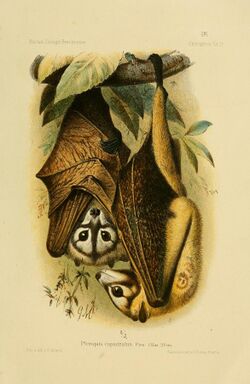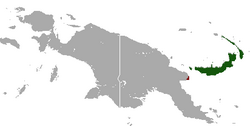Biology:Bismarck masked flying fox
| Bismarck masked flying fox | |
|---|---|

| |
| Scientific classification | |
| Domain: | Eukaryota |
| Kingdom: | Animalia |
| Phylum: | Chordata |
| Class: | Mammalia |
| Order: | Chiroptera |
| Family: | Pteropodidae |
| Genus: | Pteropus |
| Species: | P. capistratus
|
| Binomial name | |
| Pteropus capistratus Peters, 1867
| |

| |
| Bismarck masked flying fox range (green — native, brown — vagrant) | |
| Synonyms | |
| |
The Bismarck masked flying fox (Pteropus capistratus) is a species of flying fox in the family Pteropodidae found in Papua New Guinea and named after the Bismarck Archipelago. It was once considered a subspecies of Pteropus temminckii before being reassessed in 2001. This species has two subspecies, P. c. capistratus and P. c. ennisae.[2] The IUCN classified it as Near Threatened in 2009, noting that the rate of decline is almost high enough to reclassify the species as Vulnerable.[1]
Taxonomy
The Bismarck masked flying fox was described as a new species in 1867 by German naturalist Wilhelm Peters.[3] Prior to 1995, the Bismarck masked flying fox was largely considered a subspecies of the Temminck's flying fox (Pteropus temminckii).[4]
Description
Its forearm length is 109–118 mm (4.3–4.6 in).[5]
Biology and ecology
It is one of the rare species of mammals in which the males can lactate.[6] It is generally solitary, though males and females may roost together in pairs.[7]:6
Range and habitat
The Bismarck masked flying fox is endemic to Papua New Guinea where it has been documented at a range of elevations from 0–1,200 m (0–3,937 ft) above sea level.[1]
Conservation
As of 2021, it is evaluated as a vulnerable species by the IUCN. It meets the criteria for this designation because it has a small population size, likely numbering fewer than 10,000 mature individuals. It is experiencing significant habitat loss and population decline.[1]
References
- ↑ 1.0 1.1 1.2 1.3 Pennay, M.; Lavery, T.H.; Roberts, B. (2021). "Pteropus capistratus". IUCN Red List of Threatened Species 2021: e.T84891540A22012219. doi:10.2305/IUCN.UK.2021-3.RLTS.T84891540A22012219.en. https://www.iucnredlist.org/species/84891540/22012219. Retrieved 16 December 2023.
- ↑ D.E. Wilson & D.M. Reeder, 2005: Mammal Species of the World: A Taxonomic and Geographic Reference. Third Edition. The Johns Hopkins University Press, Baltimore
- ↑ Peters, W. (1867). "Mittheilung über die Pelzrobbe von den Inseln St. Paul und Amsterdam und über die von S.M.S. Gazelle mitgebrachten Flederthiere" (in de). Monatsberichte der Königlichen Preussische Akademie des Wissenschaften zu Berlin: 316–317. https://biodiversitylibrary.org/page/35329673.
- ↑ "Pteropus capistratus". https://www.itis.gov/servlet/SingleRpt/SingleRpt?search_topic=TSN&search_value=945983#null.
- ↑ Flannery, T. F. (1995). Mammals of the south-west Pacific & Moluccan Islands. Cornell University Press. p. 184. ISBN 978-0801431500.
- ↑ Bats: A World of Science and Mystery (Hardcover) by M. Brock Fenton, Nancy B. Simmons, p. 168.
- ↑ Pierson, E. D.; Rainey, W. E. (1992). "The biology of flying foxes of the genus Pteropus: a review". Biological Report 90 (23). https://www.researchgate.net/publication/235094381.
Wikidata ☰ Q1763843 entry
 |


